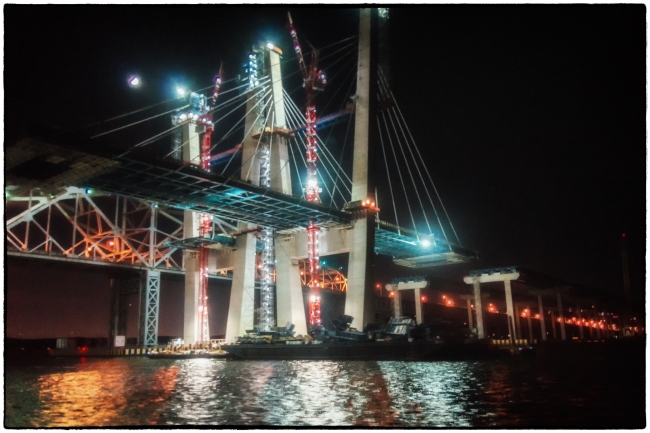According to Wikipedia:
The Governor Malcolm Wilson–Tappan Zee Bridge, usually referred to as the Tappan Zee Bridge, is a cantilever bridge in the U.S. state of New York, crossing the Hudson River at one of its widest points; the Tappan Zee is named for an American Indian tribe from the area called “Tappan”; and zee being the Dutch word for “sea”. As an integral conduit within the New York Metropolitan Area, it connects South Nyack in Rockland County with Tarrytown in Westchester County in the Lower Hudson Valley. Federal and state authorities are currently constructing a replacement bridge, the New Tappan Zee Bridge that will cost at least $4 billion.
The bridge is part of the New York State Thruway mainline and carries the highway concurrency of Interstate 87 and Interstate 287. The span carries seven lanes of motor traffic. The center lane can be switched between eastbound and westbound traffic depending on the prevalent commuter direction; on weekdays the center lane is eastbound in the morning and westbound in the evening. The switch is accomplished via a movable center barrier which is moved by a pair of barrier transfer machines. Even with the switchable lane, traffic is frequently very slow. The bridge is one of the primary crossings of the Hudson River north of New York City; it carries much of the traffic between southern New England and points west of the Hudson. It is the longest bridge in the State of New York. The total length of the bridge and approaches is 16,013 feet (4,881 m). The cantilever span is 1,212 feet (369 m) providing a maximum clearance of 138 feet (42 m) over the water. The bridge is about 25 miles (40 km) north of Midtown Manhattan, the skyline of which can be seen from the bridge on a clear day.
Unfortunately it’s now falling apart. According to the same Wikipedia article:
The deteriorating current structure bears an average of 138,000 vehicles per day, substantially more traffic than its designed capacity. Unlike other major bridges in metropolitan New York, the Tappan Zee was designed to last only 50 years due to material shortages during the Korean War at the time of its construction. The new bridge is intended to last at least 100 years.
The collapse of Minnesota’s I-35W Mississippi River bridge in 2007 raised worries about the Tappan Zee’s structural integrity. These concerns, together with traffic overcapacity and increased maintenance costs, escalated the serious discussions already ongoing about replacing the Tappan Zee with a tunnel or a new bridge. Six options were identified and submitted for project study and environmental review.
In 2009, the Tappan Zee Bridge was featured on The History Channel “The Crumbling of America” showing the infrastructure crisis in the United States. Many factors contribute to the precarious infrastructure of the bridge, which has been called “one of the most decrepit and potentially dangerous bridges” in the U.S. Engineering assessments have determined that “everything from steel corrosion to earthquakes to maritime accidents could cause major, perhaps catastrophic, damage to the span,” prompting one of the top aides in the New York state governor’s office to refer to the Tappan Zee as the “hold-your-breath bridge.” A 2009 state report noted that the bridge was not built with a plan that was “conducive to long-term durability” and that the Tappan Zee’s engineers designed it to be “nonredundant,” meaning that one “critical fracture could make the bridge fail completely because its supports couldn’t transfer the structure’s load to other supports.”
The Metropolitan Transportation Authority (MTA) studied the feasibility of either including a rail line across the new bridge or building the new bridge so a new rail line can be installed at a future date. Commuter rail service west of the bridge in Rockland County is limited, and the MTA studied expansion possibilities in Rockland County that would use the new bridge to connect with Metro-North’s Hudson Line on the east side of the bridge along the Hudson River for direct service into Manhattan. On September 26, 2008, New York state officials announced their plan to replace the Tappan Zee Bridge with a new bridge that included commuter-train tracks and lanes for high-speed buses. The bridge was estimated to cost $6.4 billion, while adding bus lanes from Suffern to Port Chester was estimated to cost an additional $2.9 billion. Adding a rail line from the Suffern Metro-North station and across the bridge, connecting with Metro-North’s Hudson Line south of Tarrytown, would have added another $6.7 billion. The plan was reviewed for its environmental impacts.
Meetings by the New York State Department of Transportation with local communities were held in December 2009. They revised the replacement cost including road, rail, and bus up to $16 billion. In 2013, the New York State Thruway Authority began building the New Tappan Zee Bridge, which will be a double-span bridge (four lanes per span in opposite directions) with designated bus lanes. The new bridge is scheduled for completion in 2018.
This picture was taken as our boat passed under the two bridges: the new one in the foreground, and the old one in the background.

